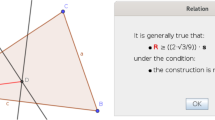Abstract
How to automatically generate short and easy-to-understand proofs for geometric theorems has long been an issue of concern in mathematics education. A novel automated geometric theorem proving method based on complex number identities is proposed in this paper, which acts as a bridge between geometry and algebra. According to the proposed method, the geometric relations in the given proposition are first transformed into a complex number expression, then the complex number identity is generated by the elimination method; finally, the closure property under all four operations of real numbers is employed to prove the proposition. A test on more than 300 geometric problems shows that the proposed method is highly effective, and the corresponding proofs are short, with obvious geometric meaning.















Similar content being viewed by others
References
Buchberger, B.: Gröebner bases: an algorithmic method in polynomial ideal theory. In: Multidimensional Systems Theory-Progress, Directions and Open Problems in Multidimensional Systems. Reidel Publishing Company, pp. 184–232 (1985)
Cao, N.B., Li, H.B., Zhang, S.P.: Geometric decomposition and its program implementation based on conformal geometric algebra. Acta Mathematicae Applicatae Sinica 30(5), 891–902 (2007). (in Chinese)
Chang, G.Z.: Complex Number Calculation and Geometry Proof. Shanghai Education Press, Shanghai (1980). (in Chinese)
Chou, S.C.: Mechanical Geometry Theorem Proving. D. Reidel, Boston (1988)
Chou, S.C., Gao, X.S., Zhang, J.Z.: Mechanical geometry theorem proving by vector calculation. In: Proceedings of the 1993 International Symposium on Symbolic and Algebraic Manipulation, Kiev, ACM Press (1993)
Chou, S.C., Gao, X.S., Zhang, J.Z.: A collection of 110 geometry theorems and their machine proofs based on full-angles. TR-94–4, Department of Computer Science, WSU (1994)
Chou, S.C., Gao, X.S., Zhang, J.Z.: Machine Proofs in Geometry. World Scientific, Singapore (1994)
Chou, S.C., Gao, X.S., Zhang, J.Z.: Automated generation of readable proofs with geometric invariants I. Multiple and shortest proof generation. J. Autom. Reason. 17(3), 325–347 (1996)
Chou, S.C., Gao, X.S., Zhang, J.Z.: Automated generation of readable proofs with geometric invariants II. Theorem proving with full-angles. J. Autom. Reason. 17(3), 349–370 (1996)
Chou, S.C., Gao, X.S., Zhang, J.Z.: A deductive database approach to automated geometry theorem proving and discovering. J. Autom. Reason. 25(3), 219–246 (2000)
Chou, S., Schelter, W.: Proving geometry theorems with rewrite rules. J. Autom. Reason. 2, 253–273 (1986)
Ge, Q., Zhang, J.Z., Chen, M., Peng, X.C.: Automated geometry readable proving based on vector. Chin. J. Comput. 37(8), 1809–1819 (2014)
Johnson, R.A.: Advanced Euclidean geometry. Houghton Mifflin Company, Boston (1929)
Kapur, D.: Geometry theorem proving using Hilbert’s Nullstellensatz. In: Proceedings of the 1986 Symposium on Symbolic and Algebraic Computation, Waterloo, pp. 202–208 (1986)
Li, H., Xu, R., Zhang, N.: On Miquel’s Five-Circle Theorem. In: Li, H., Olver, P.J., Sommer, G. (eds.) Computer Algebra and Geometric Algebra with Applications. IWMM GIAE 2004 2004. Lecture Notes in Computer Science, vol. 3519. Springer, Berlin (2005)
Li, T., Zhang, J.: Machine proofs in geometry based on complex number method. J. Comput. Res. Dev. 50(9), 1963–1969 (2013)
Peng, X.C.: Vector, Complex Number and Particle. China University of Science and Technology Press, Hefei (2014). (in Chinese)
Peng, X.C., Chen, Q.H., Zhang, J.Z., Chen, M.: Automated discovery of geometric theorems based on vector equations. J. Autom. Reason. 65, 711–726 (2021)
Tao, L.I., Zou, Y., Zhang, J.Z., et al.: Improvement of the complex mass point method and its application in automated geometry theorem proving. Chin. J. Comput. 38(08), 1640–1647 (2015)
Titu, A., Dorin, A.: Complex Numbers from A to Z. Birkhäuser, Boston (2005)
Wang, D.M.: Elimination Methods. Springer, Wien New York (2001)
Wu, W.T.: Mechanical Theorem Proving in Geometries: Basic Principles. Springer, New York (1994)
Wu, W.T.: Mathematics Mechanization. Science Press, Kluwer (2000)
Yang, L., Xia, B.C.: Automated Proving and Discovering on Inequalities. Science Press, Beijing (2008)
Ye, Z., Chou, S.C., Gao, X.S.: Visually dynamic presentation of proofs in plane geometry. J. Autom. Reason. 45(3), 213–241 (2010)
Zhang, J.Z., Peng, X.C.: Solving Geometry Problems with Vector Method. Science Press, Beijing (2010). (in Chinese)
Zhang, J.Z., Peng, X.C.: Point Geometry Problem Solving. East China Normal University Press, Shanghai (2020). (in Chinese)
Zhang, J.Z., Peng, X.C., Chen, M.: Self-evident automated proving based on point geometry from the perspective of Wu’s method identity. J. Syst. Sci. Complexity 32(1), 78–94 (2019)
Zou, Y., Peng, X.C., Rao, Y.S.: Identity method of geometric theorem proving based on Wu’s method. Science China Math. 51, 289–300 (2021). (in Chinese)
Acknowledgements
This work was financially supported by the Research Funds from the National Natural Science Foundation of China (Grant No. 62077019).
Author information
Authors and Affiliations
Corresponding authors
Additional information
Publisher's Note
Springer Nature remains neutral with regard to jurisdictional claims in published maps and institutional affiliations.
Rights and permissions
Springer Nature or its licensor (e.g. a society or other partner) holds exclusive rights to this article under a publishing agreement with the author(s) or other rightsholder(s); author self-archiving of the accepted manuscript version of this article is solely governed by the terms of such publishing agreement and applicable law.
About this article
Cite this article
Peng, X., Zhang, J., Chen, M. et al. Self-evident Automated Geometric Theorem Proving Based on Complex Number Identity. J Autom Reasoning 67, 38 (2023). https://doi.org/10.1007/s10817-023-09688-w
Received:
Accepted:
Published:
DOI: https://doi.org/10.1007/s10817-023-09688-w




